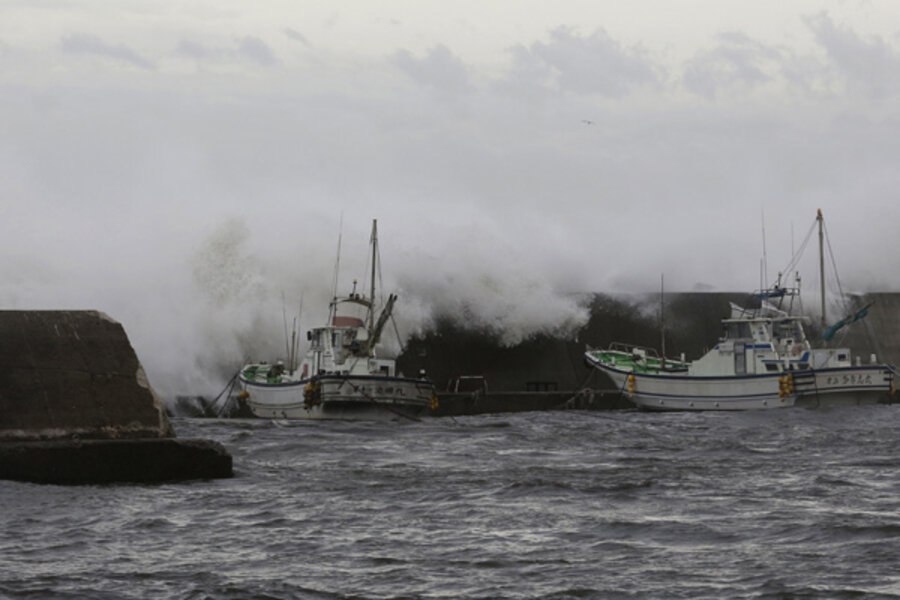Typhoon Man-yi causes two deaths in Japan, thousands told to evacuate
Loading...
| Tokyo
A powerful typhoon lashed Japan with torrential rain Monday, leaving two dead as it damaged homes and flooded parts of the country's popular tourist destination of Kyoto, where 260,000 people were ordered to evacuate to shelters.
Typhoon Man-yi, packing wind speeds of 162 kilometers per hour (100 mph) Monday night, was centered off the northern coast and heading to the northern main island of Hokkaido, dumping more heavy rain.
Trains in Tokyo and its vicinity were largely suspended and hundreds of flights were grounded. At Tokyo's Yasukuni war shrine, a janitor was hit by a fallen tree and seriously injured. Most transportation resumed in the area by Monday evening.
Dozens of people were injured. Police and disaster management officials said the body of a 72-year-old woman was dug out of the debris of her home, which was smashed by a mudslide the night before in Shiga prefecture, east of Kyoto. A 77-year-old woman was found dead in a mudslide in Fukui prefecture.
The Meteorological Agency said the storm dumped an "unprecedented" amount of rainfall in Kyoto and two neighboring prefectures it passed overnight, dumping as much as 8 centimeters (3 inches) per hour. It lifted a "special warning" for the area Monday but urged residents to stay alert.
In Kyoto, where the city's major Katsura River flooded, some 260,000 people in the prefectural capital alone were told to evacuate. Hundreds of thousands of others were also ordered to evacuate across Japan.
Tourists in Kyoto were taken to safety on boats towed by rescue workers on a flooded riverside street near the normally scenic Arashiyama area.
Water gushed into a nearby hotel, flooding the lobby and the kitchen, where it knocked down a big refrigerator.
"The water in the lobby was up to the waist. I just didn't know what to do when I saw that," hotel manager Makoto Hasegawa told public broadcaster NHK as he rinsed the hotel entrance with fresh water.
In the nearby town of Fukuchiyama, an aerial view showed a vast area of muddy water swallowing the town, with houses, fields or other structures half-submerged. The town's entire population of more than 81,000 was ordered to evacuate.
The government set up an emergency task force to assess damage and support rescue efforts, said Prime Minister's Office official Hikariko Ono. Kyoto and Shiga prefecture asked the Defense Ministry to mobilize relief teams.
More than 100 people were injured across the country by Monday evening, NHK said, citing its own tally. A man was missing after he went to check fish traps in a river in Fukushima prefecture. A 41-year-old woman and her daughter, a fifth-grader, were missing in Mie, central Japan, apparently swept away by a swollen river.
Thousands of homes were flooded across Japan, according to NHK, and about 80,000 houses in the region were without electricity earlier Monday.
As a preventive step, workers at the crippled Fukushima Dai-ichi nuclear power plant, about 250 kilometers (155 miles) northeast of Tokyo, were pumping away rainwater that was pooling around hundreds of storage tanks containing radioactive water.
Plant operator Tokyo Electric Power Co. said the rainwater was being released to the ocean and was believed to be untainted. TEPCO said it was pumping away the water to reduce the risk of flooding and potential tank leaks mixing with rainwater, then seeping into the soil or flowing into the sea.
The government's Nuclear Regulation Authority, however, said the pumping and release of the rainwater into the ocean was possibly "an event" subject to reporting under nuclear safety rules. TEPCO said the radioactivity in the released water was within allowed discharge limits, but duty regulators at the plant were checking.
Recent acknowledgements by officials that contaminated water is leaking from the plant have triggered safety concerns.







